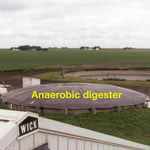



Making On-Farm Waste Digestion Work
US - Scientists have optimised an environmentally effective process to reduce the amount of animal waste on the farm. Key is establishing levels of the 'right' microbes.Animal waste has always been a great potential source of bioenergy and a natural fertilizer, but finding a green waste management process has been problematic. Not any more.
With funding from USDA's Cooperative State Research, Education, and Extension Service (CSREES) National Research Initiative (NRI), scientists in Missouri have optimized an environmentally effective process to reduce the amount of animal waste on the farm.

(Picture: Lars Angenent)
Traditional waste management practices require storage of waste products in open lagoons where the material is broken down by microbes in the absence of oxygen. Other common waste management practices involve unrestricted land application. Both methods are loosing favour due to their negative impacts on the environment through the release of nutrients in runoff water and greenhouse gases into the atmosphere.
Another method is the use of microbial digesters. To date, implementation of digesters on US farms to treat animal manure has had high failure rates – but that may about to change.
Rebecca Hoffmann and colleagues at Washington University determined how to make waste digesters more efficient. They found that different mixing intensities did not have an affect on long-term performance, but did affect the microbial populations responsible for breaking down the waste. By controlling the microbe community, they affected the overall stability of the digestion process.
The scientists determined that microbial digestion improves when mixed at low speeds during the startup of the digester; however, higher mixing speeds during later periods may improve long-term stability. More mixing reduces the net surplus of bioenergy produced.
"Moving animal waste directly and often from animal housing to [oxygen-reduced] digesters degrades odorous molecules, which results in less odor to surrounding communities," said contributing scientist, Lars Angenent.
Mixing is an essential component of effective waste material digestion; it brings the slurry into contact with the microbes responsible for breaking down the waste. Mixing also regulates the slurry environment, including pH, temperature, and particle size, to ensure that the microbes remain active during the digestion process. Mixing also aids in the removal of biogas.
Project results also suggest that many species of the microbe Methanosarcina were more efficient at producing methane gas during the digestion process. The scientists believe this microbe may be selected naturally by increased mixing and lead to improved long-term stability.
"Digestion of animal waste can generate much more bioenergy in the form of methane gas than [the farm can use] to run their fans, heating, cooling, etc.," Dr Angenent said. "Therefore, converting methane gas in a generator on the farm can produce a large surplus of electricity that can be sold to the local utility company's power grid."









